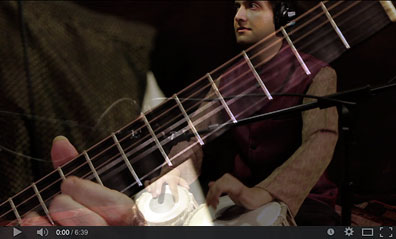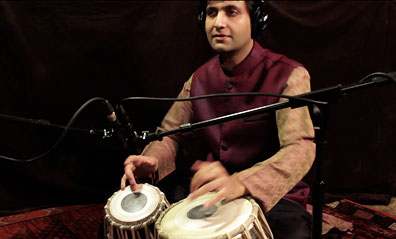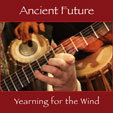Issue 14. Summer 2014:
Welcome to the World Rhythms News, an infrequent newsletter dedicated to world music education. To subscribe, use the form below. Follow instructions thereafter, and make sure to check "World Music Education" in the "Interests" section of the sign up process.
In this issue:
Section One: North Indian Raga and Tala
- Raga: Rag Kalyan
- Rhythmic Cycles: Tintal and Matta Tal
- Yearning for the Wind Video in Rag Kalyan and Matta Tal
Section Two: Further Study
Section One: North Indian Raga and Tala
Raga

A raga is a melodic recipe for a mood. Raga could be described as a "super scale" using a set of notes in ascending (arohi) and descending (avarohi) order, sometimes including prescribed alternate routes, a hierarchy of note importance, and a key phrase that shows the heart of the movement of the raga. This ancient system is both an art and a science of how musical notes create certain moods. The recipe for each raga holds the key to an unlimited number of potential melodies, each perpetuating the mood contained in the raga.
Rag Kalyan
Rag Kalyan is an evening raga that falls within a scale corresponding to the Western Lydian mode, which is a major scale with an augmented fourth. From C, the scale would be as shown below (a dote above a note indicates the octave above, a dot below indicates the octave below):
.
C D E F# G A B C
1 2 3 #4 5 6 7 8But Rag Kalyan is more than just a scale. Ascending passages start on the major seventh below the root, and skip the tonic and often the fifth:
.
B D E F# A B C
.
7 2 3 #4 6 7 8Descending passages employ the full scale:
. C B A G F# E D C 8 7 6 5 #4 3 2 1
The vadi, or dominant note of a raga, is the major 3rd. It can be a note that passages pause on. The samavadi, the second-most prominent note, is the major 7th, which is the note ascending passages start on.
Rhythmic Cycles

The concept of the ever-recurring cyclic rhythms of the universe is one of the basic tenets of Hindu philosophy. The perception of the cyclic nature of life is reflected in Indian classical music through the device of tala, a recurring time-measure or rhythmic cycle.
In the same way that raga can be described as a “super scale,” tala is a “super time signature,” a recurring time-measure or rhythmic cycle with distinct sections. The beats have different degrees of emphasis within a tala, and are marked with a system of hand claps, hand waves and movements of the fingers. The most important point of rhythmic emphasis is the sam, the first beat of the tala and point to which all variations eventually return. It is represented by the symbol "+," and is marked by a hand clap. The khali, literally the empty beat, is the unaccented beat of the tala. The lack of accent is emphasized, making the khali a very important beat. It is marked by a wave of the hand and is written with the symbol "o." Talas have other accented beats known as tali, also marked by hand claps. In written notation, the tali are numbered, starting with the number two. In this presentation, each beat is equally subdivided by the number of syllables it contains. For example, in beat one of matta tal, the syllable "dhin" is equal to one beat, and in beat two "terikita" is played as four sixteenth notes. To practice reciting theka, use this pronunciation guide to Indian drum syllables.
There are an estimated 350 talas in North Indian music, of which ten are in common use. Presented here is the most common tala, the 16 beat tintal, and one of the least, the nine beat matta tal. Each tala has a theka, which is a standard groove represented by onomatopoeic drum syllables and played as an accompaniment. Click on the tabla head ![]() below to hear audio of the thekas:
below to hear audio of the thekas:
Tintal
16 beats, divided 4 + 4 + 4 + 4:
+ 2 o 3
|: dha dhin dhin dha dha dhin dhin dha na tin tin ta ta dhin dhin dha :|
1 2 3 4 5 6 7 8 9 10 11 12 13 14 15 16
Matta Tal
9 beats, divided 4 + 2 + 3. In this case, the final 3 beats are subdivided 1 1/2 + 1 1/2: + o 2
|: dhin terikita dhin na tin na dhin dhin na dhin dhin na :|
1 2 e + a 3 4 5 6 7 + 8 + 9 +
1 2 3 4 5 6 1 2 3 1 2 3
'Yearning for the Wind' Video in Rag Kalyan and Matta Tal

YouTube Video of 'Yearning for the Wind' with Matthew Montfort and Vishal Nagar
Reached the #1 Position on the Ethnocloud World Music Chart
Recorded in hi-res audio and video in December 2013, Yearning for the Wind is the first audio/video release in Ancient Future history. This evocative piece was produced for The Archive of Future Ancient Recordings, Ancient Future's ambitious ongoing fan-funded project. Yearning for the Wind is the first EP and video to be released to raise awareness of the archive.
Composed by scalloped fretboard guitar innovator Matthew Montfort, Yearning for the Wind is a poignant piece based on Rag Kalyan. The composition also incorporates harmony and other guitaristic elements, and in passages follows the muse of the moment over the rules of raga.
Yearning for the Wind starts with an alap, an introductory melodic improvisation that shows how the raga moves. This short alap truncates some of traditional forms that are used in longer expositions. It starts slow and unmetered, but instead of developing into a traditional jor, the section of the alap in which a steady pulse appears, it introduces harmonies as a way of increasing intensity.
Once the alap comes to a conclusion, the slow gat, or main theme, is introduced in the tala. The nine beat matta tal provides an intriguing setting for this duet with Indian tabla virtuoso Vishal Nagar, who is considered one of the most gifted tabla players of his generation. The gat starts with the main melody in the lower register, or the asthai, followed by the antara, a second section of the melody in the higher register. Then there is a melodic guitar improvisation over the tala with a light harmonic rhythm guitar background instead of the traditional drone.
After the gat is reprised, a new theme is introduced that puts a phrase of four against the final three beats of the nine beat tala. It is used as a lahara, an ostinato employed to accompany a tabla solo. Vishal begins his solo by exploring the main tabla sounds which flow with the soft groove of the nine beat rhythm. He slowly builds up to a vibrant rela (a fast tabla composition characterized by rapid drum rolls) utilizing a tishra jati (triplet) bridge that draws from the end of the matta tal theka for a graceful transition that remains attuned to the mood of the composition.
The fast gat that follows also employs the phrasing of four against the final three beats of the tala. There is another improvised guitar solo, followed by a fixed ending that employs a guitaristic riff followed by a tihai: a rhythmic phrase repeated three times and timed to end on the sam, the first beat of the tala. In this case, the tihai has a high ostinato played against it by the rhythm guitar that helps further enhance the climax of the tihai. This is followed by the lahara, this time played in the high register, with a second (and faster paced) tabla solo, followed by another tihai, into a restatement of the antara of the fast gat, followed by the final tihai. The piece ends with the rhythm guitar fading on an accompaniment ostinato similar to what a swarmandal, or Indian harp, might play.
Yearning for the Wind by Ancient Future. Ancient-Future.Com AF-90352. Signed Enhanced Audio/Video E-CD-R-$17.98: Buy E-CD Now. iTunes.
Section Two: Further Study
Rhythm Training Book Sale
Ancient Traditions - Future Possibilities
Book/Enhanced Audio CD Set with MIDI Soundfiles: $52.95 (SALE! Normally $69.95): Buy 1 Now.
"You've heard Afro-Pop, sitar, gamelan and world music for years. But do you know what they are and how they work? Better yet, would you like to play those twisted cross-rhythms and melodies? In Ancient Traditions--Future Possibilities, Matthew Montfort, a founding member of the world music band Ancient Future, has put together the book for people who want to dig into world music with both hands. Wherever possible, Montfort has provided beat counts alongside the standard musical notation so even if you can't read music, you can still learn the rhythms." – Richard Kadrey, SAN FRANCISCO CHRONICLE
Music Lessons Via Skype
And Other Multimedia File Exchange Methods
Private Lessons with Matthew Montfort
Study any of the subjects on the education section of Ancient-Future.Com through private correspondence lessons (via Skype or any method of file exchange) with Ancient Future bandleader and guitarist, Matthew Montfort. Feel free to email info@ancient-future.com with any questions you may have about how correspondence lessons can help you in your musical development!
All compositions, recordings, video, and text in this article © 2014 Ancient Future Music. All rights reserved.






